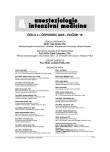Systemic mycosis in ICU: new diagnostic and treatment opportunities
Authors:
J. Haber 1; I. Novák 2
Authors‘ workplace:
I. interní klinika Všeobecné fakultní nemocnice, Praha
1; JIP I. interní kliniky Fakultní nemocnice, Plzeň
2
Published in:
Anest. intenziv. Med., 16, 2005, č. 4, s. 197-202
Category:
Intensive Care Medicine - Original Paper
Overview
The incidence of invasive fungal infections in the critical care setting has steadily increased in the past couple of decades. Candida spp. are the fourth most common cause of nosocomial bloodstream infections worldwide. Candidiasis and other invasive mycotic infections have been widely reported in intensive care units (ICU). These infections are particularly severe, with mortality rates ranging from 35% to 60%. Preventing their development is very enticing but treatment can be costly, both financially and with regard to resistance and toxicity. On the other hand pre-emptive treatment has been found a very useful strategy in reducing the incidence of ICU-acquired proven invasive mycotic infection in highly colonized patients. The modern diagnostic approach consists of using all available diagnostic means, including antigen and antibody detection, PCR techniques, early indication of high resolution CT scan and possibly tissue biopsy for histological confirmation. Current therapy recommendations are evidence based and include: 1. Voriconazole has become the 1st line treatment of invasive aspergillosis; 2. The range of antifungals used for the 1st line treatment in invasive candidiasis is now wider – caspofungin and voriconazole as well as amphotericin B and fluconazole; 3. Caspofungin and voriconazole have also proved useful in empiric antifungal therapy.
Key words:
invasive mycosis – Candida – Aspergillus – antifungals – infection – sepsis
Labels
Anaesthesiology, Resuscitation and Inten Intensive Care MedicineArticle was published in
Anaesthesiology and Intensive Care Medicine

2005 Issue 4
Most read in this issue
- Systemic mycosis in ICU: new diagnostic and treatment opportunities
- PIRO concept – ”P“ (predisposition) and sepsis
- ANZICS: Statement on withholding and withdrawing treatment
- Influence of interleukin-6 and tumor necrosis factor α gene polymorphisms on acute pain perception
